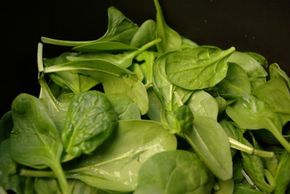Q. What can you do with a bag of fresh spinach?
A. A big bag of greens is loaded with convenience: Bagged spinach is already rinsed, dried, and ready to go, and it cooks almost instantly. Spinach can also be served year round; it doesn't have a specific season to depend on for peak flavors.
This nutrient-dense veggie is jam-packed with nutrients, too: A nice-sized salad can give you more than 100 percent of your daily requirement for vitamin A.
Advertisement
In addition to being packed with nutrition, spinach is also a versatile ingredient in the kitchen and on the stove. Here are some ideas for how to use fresh spinach:
- Try adding spinach to a wrap or stuff your sandwiches with spinach instead of iceberg lettuce.The leaves add color and bulk to your meal without adding too many calories.
- Spinach cooks quickly in soups and stews and adds color as well as nutrients to your warm kettle.
- Try tossing spinach in a salad on its own or with other greens and fresh vegetables. Add a few pecans or walnuts with dried cranberries and blue cheese for a great burst of flavor.
- For a speedy side dish, quickly sauté an entire bag of spinach in a bit of butter and lightly season with salt and pepper.
- Use a bed of sautéed spinach in place of rice or noodles with your favorite stir-fry recipe.
- Coarsely chop the leaves and toss them into a pasta salad or in a hot pasta dish; the heat from the pasta is just enough to slightly wilt the leaves.
Q. What is the best way to clean spinach so that all the sand and dirt gets out?
A. The easiest way to sidestep this problem is to buy bagged, rewashed spinach. That way, the only thing you need to do is give the leaves a quick rinse before using them.
If bagged spinach is not an option, cleaning fresh bunch spinach is not difficult -- just a bit time-consuming. Here's a simple step-by-step set of instructions on the best way to clean your fresh spinach:
- To thoroughly remove all the dirt and grime, fill up your kitchen sink with cold water.
- Discard the bruised and damaged leaves from the spinach and remove the stems from the remaining leaves.
- Place the spinach leaves in the water, swirl them around to release some of the dirt, and let them soak in the sink for several minutes. The dirt will end up settling to the bottom of the sink.
- Transfer the leaves from the sink to a colander, drain the sink, and repeat the process until the spinach is clean.
If fresh spinach isn't an option, frozen spinach is a good alternative for cooking -- although to get the most nutrients out of your spinach, fresh leaves are usually the best way to go.
Advertisement
